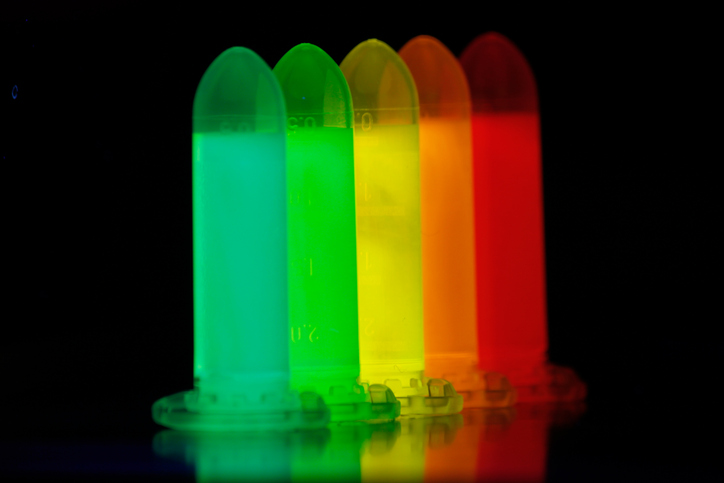 Researchers have found an explanation for why a certain class of quantum dots shines with such incredibly bright colors.
Researchers have found an explanation for why a certain class of quantum dots shines with such incredibly bright colors.
The nanocrystals in question contain caesium lead halide compounds arranged in a perovskite lattice structure. Three years ago, Maksym Kovalenko, a professor at ETH Zurich and the Swiss Federal Laboratories for Materials Science and Technology (Empa), succeeded in creating nanocrystals from the same semiconductor material.
“These tiny crystals have proved to be extremely bright and fast emitting light sources, brighter and faster than any other type of quantum dot studied so far,” says Kovalenko.
By varying the composition of the chemical elements and the size of the nanoparticles, Kovalenko also produced a variety of nanocrystals that light up with the colors of the entire visible spectrum. These quantum dots could be used as components for future light-emitting diodes (LEDs) and displays.
In their study, the researchers examined these particular nanocrystals individually and in great detail. They confirmed that this class of nanocrystals emit light extremely quickly. Previously-studied quantum dots typically emit light around 20 nanoseconds after being excited when at room temperature, which is already very quick.
“However, caesium lead halide quantum dots emit light at room temperature after just one nanosecond,” explains the study’s first author, Michael Becker, a doctoral student at ETH Zurich who is carrying out his doctoral project at IBM Research.
To understand why caesium lead halide quantum dots are not only fast but also very bright, researchers had to dive into the world of individual atoms, light particles (photons), and electrons.
“You can use a photon to excite semiconductor nanocrystals so that an electron leaves its original place in the crystal lattice, leaving behind a hole,” explains David Norris, professor of materials engineering. The result is an electron-hole pair in an excited energy state. If the electron-hole pair reverts to its energy ground state, it emits light.
Under certain conditions, different excited energy states are possible. In many materials, the most likely of these states is called a dark state.
“In such a dark state, the electron hole pair cannot revert to its energy ground state immediately and therefore the light emission is suppressed and occurs delayed. This limits the brightness,” says Rainer Mahrt, a scientist at IBM Research.
The research shows that the caesium lead halide quantum dots differ from other quantum dots: their most likely excited energy state is not a dark state. Excited electron-hole pairs are much more likely to find themselves in a state in which they can emit light immediately.
“This is the reason that they shine so brightly,” says Norris.
The researchers came to this conclusion using their new experimental data—and with the help of theoretical work led by Alexander Efros, a theoretical physicist at the Naval Research Laboratory in Washington. Efros is a pioneer in quantum dot research, among the first scientists to explain how traditional semiconductor quantum dots function 35 years ago.
Because the examined caesium lead halide quantum dots are not only bright but also inexpensive to produce, they could be applied in television displays, a goal companies around the world are pursuing.
“Also, as these quantum dots can rapidly emit photons, they are of particular interest for use in optical communication within data centers and supercomputers, where fast, small, and efficient components are central,” says Mahrt.
This class of quantum dots could also be used in the optical simulation of quantum systems, which is of great importance to fundamental research and materials science. Norris is also interested in using the new knowledge for the development of new materials.
“As we now understand why these quantum dots are so bright, we can also think about engineering other materials with similar or even better properties,” he says.
This article appeared on Futurity. Read the article.
Source: ETH Zurich

